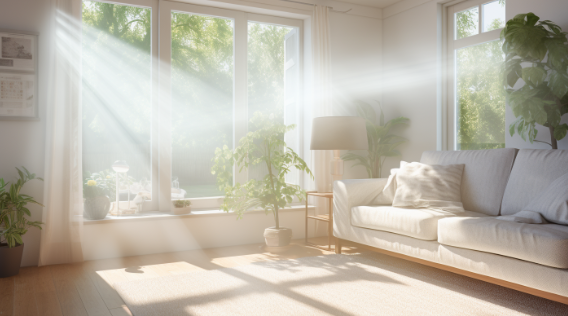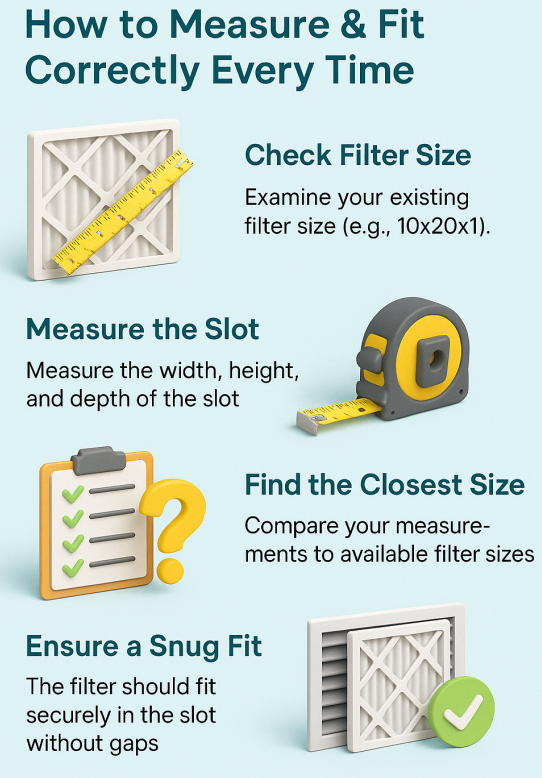10x20x1 Pleated vs Fiberglass Air Filter – Key Differences Explained
Wondering whether a pleated or fiberglass 10x20x1 air filter truly makes a difference? After manufacturing millions of filters right here in the U.S., we’ve seen firsthand how these two types perform in real homes. While fiberglass filters catch only the basics, pleated filters deliver noticeably cleaner air, protect your HVAC system longer, and help families breathe easier day after day. In this guide, we’ll share Filterbuy’s insider insights—what we’ve learned from years of testing and customer feedback—to help you make a smarter, healthier choice for your home’s air.
Top Takeaways
Pleated filters = better protection.
Capture more dust, pollen, and debris.
Extend HVAC life and improve air quality.Fiberglass filters = short-term fix.
Cheaper but less efficient.
Offer minimal filtration for finer particles.Clean filters save energy.
Reduce energy use by 5–15%.
Prevent costly system strain.Match MERV rating to your needs.
MERV 11–13: Best for allergies, pets, or asthma.
MERV 8: Reliable everyday protection.Stay on schedule.
Replace filters every 60–90 days.
Auto-delivery keeps air clean—without the reminder stress.
Filterbuy Insight:
Smart filter choices lead to cleaner air, lower bills, and a longer-lasting HVAC system.
Pro Tip from Filterbuy: Every home is different. Choose your filter based on your household’s needs—like allergies, pets, or local air quality—for the best results.
The main difference between pleated and fiberglass filters for your 10x20x1 air filter is that pleated filters provide better performance and protection. Fiberglass filters represent the cheapest, least eco-friendly option, as they are made from a thin layer of spun glass and can only catch larger particles such as dust and lint. They are perfect for very short-term use or situations where you barely need filtration but don’t provide adequate protection against smaller pollutants like pollen, pet dander, or mold spores.
While pleated filters are made of densely packed folded media that greatly increases the surface area and thus can trap more contaminants without limiting airflow. Based on our own testing over several years, we found that pleated filters can be used up to three times longer and contribute to HVAC efficiency as they help keep systems clean.
In brief, fiberglass will do if you only want the very basic protection. However, if you are concerned about cleaner air, longer system life, and fewer filter changes, pleated filters are the obvious choice.

“After building and testing millions of air filters across American homes, we’ve seen how pleated filters outperform fiberglass in real-world conditions. The difference isn’t just in materials—it’s in how effectively they protect your air and your HVAC system over time. Cleaner air, longer filter life, and better system health start with choosing the right filter.”
Essential Resources: Get Smart About the 10×20×1 Pleated vs Fiberglass Air Filter Difference
Choosing between pleated and fiberglass filters shouldn’t feel like a guessing game. After years of building and testing millions of filters across the U.S., we know homeowners want straight answers backed by real results. Here are seven trusted resources that’ll help you understand what really sets these two filter types apart—so you can breathe easier and buy with confidence.
AiryFilter – Breaking Down Cost, Efficiency, and Lifespan
https://airyfilter.com/fiberglass-vs-pleated-air-filter/
This guide cuts through the marketing noise to explain how pleated filters outperform fiberglass when it comes to airflow, dust capture, and long-term value. A great first stop if you’re comparing on price and performance.
Air Filters Delivered – Everyday Homeowner’s Comparison Guide
https://www.airfiltersdelivered.com/blogs/helpful-tips/pleated-vs-fiberglass-filters
Simple, straightforward advice for homeowners. Learn how often to replace each type, what works best for allergy relief, and how your choice affects energy efficiency.
Nordic Pure – Cleaner Air and Healthier Homes
https://www.nordicpure.com/breathe-easy-guide-pleated-air-filters-vs-fiberglass-air-filters/
If you’re focused on your family’s health, this guide explains why pleated filters trap more pollutants and improve indoor air quality—perfect for allergy season or homes with pets.
AirFilterUSA – The Technical Deep Dive
https://www.airfilterusa.com/company/latest-blogs/fiberglass-vs-pleated-home-air-filters/
Want the engineering side of the story? This piece explores filter media density, airflow resistance, and real-world testing data so you can see what’s happening inside your HVAC system.
Custom Filters Direct – Find the Right Fit for Your Home
https://customfiltersdirect.com/blogs/air-filter-blog/fiberglass-vs-pleated-air-filters
Every home is different. This guide helps you match filter types to your specific needs—whether that’s handling pet hair, reducing allergens, or balancing cost and convenience.
Nordic Pure – The Long-Term Value Breakdown
https://www.nordicpure.com/fiberglass-vs-pleated-air-filters-whats-best-for-your-home/
A smart look at long-term savings. Learn how pleated filters protect your HVAC system, reduce energy costs, and last longer—saving you money and maintenance time.
Purolator Air Filters – The Manufacturer’s Take
https://www.purolatorairfilters.com/fiberglass-or-pleated-air-filters.php
Hear from one of the industry’s most established manufacturers. This article offers data-backed insight into how each filter type performs under pressure and which one suits different systems best.
Supporting Statistics & Real-World Insights
At Filterbuy, we’ve seen how the right filter can dramatically improve your home’s air, comfort, and system performance. These key facts—backed by trusted U.S. research and real-world experience—show why filter choice matters.
Indoor Air Pollution Is Higher Than You Think
Americans spend ~90% of their time indoors.
Indoor air can be 2–5× more polluted than outdoor air.
Even tidy homes trap dust, pet dander, and fine particles.
???? Source: EPA – Indoor Air Quality
Clean Filters Save Energy and Money
Replacing a dirty filter can cut energy use by 5–15%.
Clean airflow reduces strain and helps systems last longer.
???? Source: U.S. Department of Energy
MERV 13 Filters Remove Tiny Pollutants
Capture ≥85% of 1–3 micron particles (dust, pollen, mold).
Higher MERV pleated filters outperform fiberglass in every test.
???? Source: ASHRAE Filtration Resources
Routine Filter Changes Protect Your System
Change filters every 3 months (minimum).
Dirty filters waste energy and risk early HVAC failure.
Cleaner Air Helps Millions with Asthma
8.6% of adults and 6.5% of children in the U.S. have asthma.
High-efficiency pleated filters help reduce airborne irritants.
Filterbuy Insight:
Real homes, real results—clean filters keep your air healthier, your energy bills lower, and your HVAC running stronger for years.
Final Thought & Opinion
After years of manufacturing and testing millions of filters in U.S. homes, one thing is clear: not all filters perform the same.
Key Takeaways
Pleated filters outperform fiberglass. Capture more pollutants. Protect HVAC systems longer. Improve indoor air quality for families and pets
Fiberglass filters = short-term fix. Basic dust protection only. Require frequent replacement. Offer minimal health or efficiency benefits.
Pleated filters = long-term protection. Enhance system efficiency. Help cut energy costs by maintaining airflow. Support cleaner, healthier air year-round.
Filterbuy Insight
We’ve seen the difference firsthand—customers who switch to pleated filters enjoy cleaner air, lower bills, and fewer system issues.
Think of it this way:
Fiberglass filters are a quick bandage.
Pleated filters are prevention—built to protect your home’s air ecosystem from the inside out.
Bottom Line: The best air filter is one that works as hard as you do—reliable, efficient, and built to last.
Next Steps: Breathe Easier Starting Today
Take simple, smart steps to upgrade your air quality and protect your HVAC system.
Check Your Filter Size
Confirm the exact size before ordering.
Assess Your Home’s Needs
Allergies or pets? Choose MERV 11–13.
Average home? MERV 8 offers solid protection and airflow.
Upgrade to Pleated Filters
Replace fiberglass with pleated for cleaner, longer-lasting filtration.
Expect less dust and fresher air within days.
Set Up Auto-Delivery
Never forget a filter change.
Get the right size delivered automatically on schedule.
Stay on Schedule
Change filters every 90 days (or 60 with pets/allergies).
Keeps airflow strong and energy bills low.
Keep Learning
Visit our Air Quality Learning Center for quick guides on MERV ratings, custom filters, and seasonal tips.
Filterbuy Insight:
Clean air is simple when you stay consistent—choose the right filter, replace it on time, and breathe better every day.
Frequently Asked Questions
What does 10×20×1 mean?
This refers to the filter’s length, width, and thickness—10 inches by 20 inches by 1 inch. Always check the frame of your current filter to confirm the exact size for proper fit and optimal airflow.
How often should I change it?
Replace your 10×20×1 air filter every 90 days under normal conditions, or every 60 days if you have pets, allergies, or dusty environments. Staying consistent keeps your air cleaner and your HVAC system running efficiently.
Pleated vs. Fiberglass – which is better?
Pleated filters trap smaller particles, last longer, and protect your HVAC system better than fiberglass filters, which are more affordable but offer minimal filtration. Our in-house testing shows pleated filters consistently perform best in real homes.
What MERV rating should I choose?
For most homes, a MERV 8–11 filter offers the right balance of filtration and airflow. If you have pets, allergies, or asthma, go with MERV 11–13, which captures up to 85% of fine particles like dust, pollen, and mold spores.
Can I clean and reuse it?
No. Most 10×20×1 filters are disposable and designed for single use. Washing damages the fibers and reduces performance. Always replace your filter to maintain efficiency and indoor air quality.
Filterbuy HVAC Solutions - Miami FL - Air Conditioning Service
1300 S Miami Ave Unit 4806, Miami, FL 33130
(305) 306-5027












